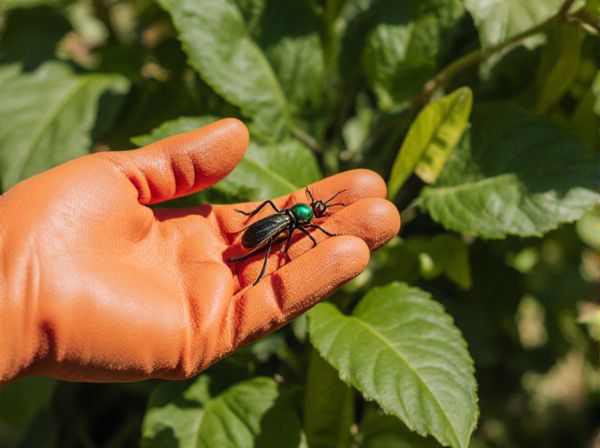
Beneficial insects vs Pest predators Illustration
Beneficial insects play a crucial role in natural pest control by preying on harmful pests and supporting plant health, whereas pest predators specifically target and reduce populations of destructive insects that damage crops. These natural allies improve ecosystem balance and reduce the need for chemical pesticides, promoting sustainable gardening practices. Encouraging the presence of both beneficial insects and pest predators enhances overall crop resilience and productivity.
Table of Comparison
| Aspect | Beneficial Insects | Pest Predators |
|---|---|---|
| Definition | Insects that enhance plant growth, pollination, or biological control. | Insects that specifically prey on or reduce pest populations. |
| Role | Pollinators, decomposers, pest controllers. | Active hunters or parasitoids of pest species. |
| Examples | Ladybugs, bees, butterflies. | Lacewings, parasitic wasps, predatory beetles. |
| Impact on Ecosystem | Promote biodiversity and plant reproduction. | Help maintain pest balance and reduce chemical use. |
| Application in Agriculture | Used for pollination and natural pest prevention. | Introduced or conserved for targeted pest management. |
Understanding Beneficial Insects in Your Garden
Beneficial insects such as ladybugs, lacewings, and parasitic wasps play a crucial role in maintaining a healthy garden ecosystem by preying on common pests like aphids, caterpillars, and scale insects. Identifying these natural predators helps gardeners reduce the need for chemical pesticides and promotes sustainable pest management. Encouraging beneficial insect populations through companion planting and habitat creation enhances plant health and boosts crop yield.
Common Pest Predators: Friends or Foes?
Common pest predators such as ladybugs, lacewings, and predatory wasps play a critical role in managing harmful insect populations by feeding on aphids, caterpillars, and other crop-damaging pests. While beneficial insects contribute to natural pest control and reduce the need for chemical pesticides, some pests may also prey on beneficial species, creating a complex ecological balance. Understanding the interactions between beneficial insects and pest predators is essential for effective companion planting and sustainable pest management strategies.
Key Differences Between Beneficial Insects and Pest Predators
Beneficial insects include pollinators like bees and decomposers such as ladybugs, which support plant health and soil quality, while pest predators specifically target and consume harmful pests, reducing plant damage. Beneficial insects contribute to ecosystem stability by providing multiple services beyond pest control, whereas pest predators have a more specialized role in managing pest populations. Understanding these key differences enhances integrated pest management strategies by optimizing the use of natural allies for crop protection.
Top Beneficial Insects Every Gardener Should Know
Top beneficial insects every gardener should know include ladybugs, lacewings, and parasitic wasps, as they effectively control common pests like aphids, mites, and caterpillars. These natural predators reduce the need for chemical pesticides by preying on harmful insects that damage plants. Incorporating beneficial insects promotes a balanced garden ecosystem and enhances overall plant health.
Identifying Pest Predators in the Garden
Identifying pest predators in the garden involves recognizing beneficial insects such as ladybugs, lacewings, and predatory beetles, which naturally control pest populations like aphids and caterpillars. These predators actively hunt and consume harmful pests, reducing the need for chemical pesticides. Monitoring plant health and insect activity helps gardeners distinguish between harmful pests and helpful predators efficiently.
How Beneficial Insects Control Garden Pests
Beneficial insects such as ladybugs, lacewings, and parasitic wasps play a crucial role in controlling garden pests by preying on aphids, caterpillars, and scale insects, effectively reducing pest populations without harmful chemicals. These natural predators maintain ecological balance, enhance plant health, and improve crop yields by targeting specific pest species. Introducing and encouraging beneficial insects in gardens supports sustainable pest management and reduces the need for synthetic pesticides.
Enhancing Your Garden to Attract Beneficial Insects
Enhancing your garden to attract beneficial insects like ladybugs, lacewings, and parasitic wasps improves natural pest control by reducing harmful pest populations such as aphids and caterpillars. Planting native flowering plants like dill, fennel, and marigolds creates a habitat rich in nectar and pollen, essential food sources for beneficial predators. Incorporating diverse plant species and avoiding chemical pesticides promotes a balanced ecosystem that supports long-term garden health and sustainable pest management.
Natural Ways to Balance Predators and Pests
Beneficial insects such as ladybugs, lacewings, and parasitic wasps naturally regulate pest populations by preying on aphids, mites, and caterpillars. Maintaining habitat diversity with flowering plants and mulch encourages these predators to thrive, enhancing pest control without chemical intervention. Employing companion planting strategies like marigolds and nasturtiums attracts beneficial insects while repelling harmful pests, promoting an ecological balance in garden ecosystems.
Avoiding Harmful Practices to Beneficial Insect Populations
Protecting beneficial insect populations requires eliminating harmful practices such as indiscriminate pesticide use and habitat destruction. Encouraging natural pest predators like ladybugs and lacewings supports ecological balance while reducing the need for chemical interventions. Maintaining diverse plant habitats enhances beneficial insect survival and pest control efficiency in companion planting systems.
Creating a Thriving Ecosystem: Beneficial Insects vs Pest Predators
Beneficial insects such as ladybugs, bees, and lacewings play a crucial role in pollination, natural pest control, and maintaining biodiversity, fostering a balanced ecosystem. Pest predators like spiders and predatory beetles actively reduce harmful insect populations, preventing crop damage and diminishing the need for chemical interventions. Integrating these insects supports a resilient agricultural environment, enhancing plant health and promoting sustainable, thriving ecosystems.
Beneficial insects vs Pest predators Infographic

 gardendif.com
gardendif.com